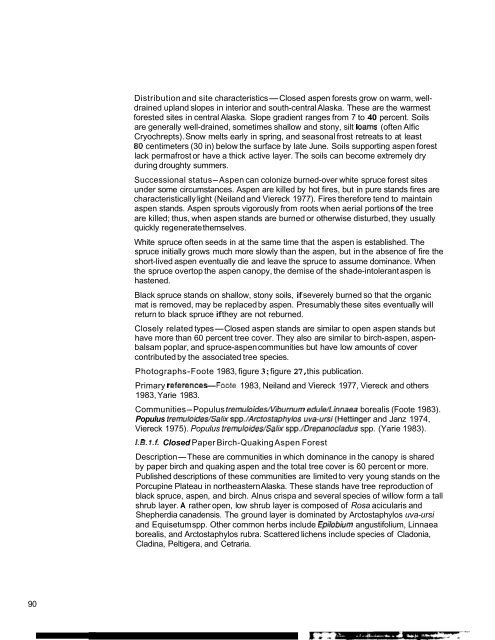The Alaska Vegetation Classification - Alaska Geobotany Center ...
The Alaska Vegetation Classification - Alaska Geobotany Center ...
The Alaska Vegetation Classification - Alaska Geobotany Center ...
Create successful ePaper yourself
Turn your PDF publications into a flip-book with our unique Google optimized e-Paper software.
Distribution and site characteristics-Closed aspen forests grow on warm, welldrainedupland slopes in interior and south-central <strong>Alaska</strong>. <strong>The</strong>se are the warmestforested sites in central <strong>Alaska</strong>. Slope gradient ranges from 7 to 40 percent. Soilsare generally well-drained, sometimes shallow and stony, silt loam (often AlficCryochrepts). Snow melts early in spring, and seasonal frost retreats to at least80 centimeters (30 in) below the surface by late June. Soils supporting aspen forestlack permafrost or have a thick active layer. <strong>The</strong> soils can become extremely dryduring droughty summers.Successional status-Aspen can colonize burned-over white spruce forest sitesunder some circumstances. Aspen are killed by hot fires, but in pure stands fires arecharacteristically light (Neiland and Viereck 1977). Fires therefore tend to maintainaspen stands. Aspen sprouts vigorously from roots when aerial portions of the treeare killed; thus, when aspen stands are burned or otherwise disturbed, they usuallyquickly regenerate themselves.White spruce often seeds in at the same time that the aspen is established. <strong>The</strong>spruce initially grows much more slowly than the aspen, but in the absence of fire theshort-lived aspen eventually die and leave the spruce to assume dominance. Whenthe spruce overtop the aspen canopy, the demise of the shade-intolerant aspen ishastened.Black spruce stands on shallow, stony soils, if severely burned so that the organicmat is removed, may be replaced by aspen. Presumably these sites eventually willreturn to black spruce if they are not reburned.Closely related types-Closed aspen stands are similar to open aspen stands buthave more than 60 percent tree cover. <strong>The</strong>y also are similar to birch-aspen, aspenbalsampoplar, and spruce-aspen communities but have low amounts of covercontributed by the associated tree species.Photographs-Foote 1983, figure 3; figure 27, this publication.Primary referencesfoote 1983, Neiland and Viereck 1977, Viereck and others1983, Yarie 1983.Communities-Populus tremuloides/Viburnum edule/Linnaea borealis (Foote 1983).Populus tremuloides/Salix spp./Arcfostaphylos uva-ursi(Hettinger and Janz 1974,Viereck 1975). Populus tremuloides/Salix spp./Drepanocladus spp. (Yarie 1983).I.B. 1.f. Closed Paper Birch-Quaking Aspen ForestDescription-<strong>The</strong>se are communities in which dominance in the canopy is sharedby paper birch and quaking aspen and the total tree cover is 60 percent or more.Published descriptions of these communities are limited to very young stands on thePorcupine Plateau in northeastern <strong>Alaska</strong>. <strong>The</strong>se stands have tree reproduction ofblack spruce, aspen, and birch. Alnus crispa and several species of willow form a tallshrub layer. A rather open, low shrub layer is composed of Rosa acicularis andShepherdia canadensis. <strong>The</strong> ground layer is dominated by Arctostaphylos uva-ursiand Equisetum spp. Other common herbs include €pi/obium angustifolium, Linnaeaborealis, and Arctostaphylos rubra. Scattered lichens include species of Cladonia,Cladina, Peltigera, and Cetraria.90
















